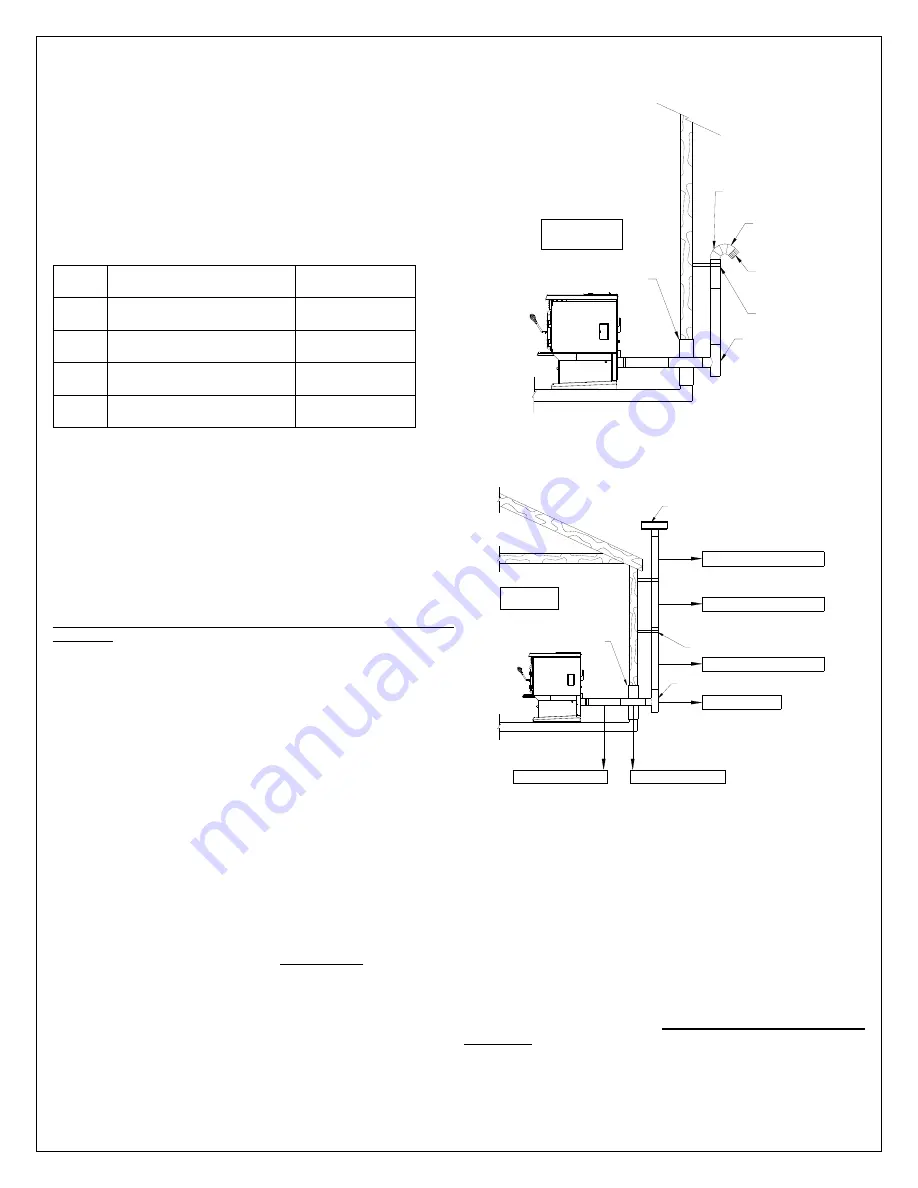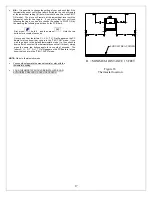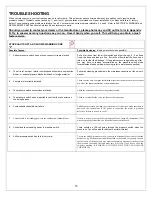
9
EQUIVALENT VENT LENGHT (EVL)
The longer the run of pipe in your installation, the greater the restriction in
the system. Therefore, larger diameter pipe should be used.
•
Use 4” pipe if you have more than
15 feet
of Equivalent Vent Length
(EVL).
•
Horizontal runs shall not exceed 10 feet of EVL.
•
To calculate EVL, use the following conversions table:
Qty
Type of pipe
EVL equivalent(ft)
1
90° elbow or “T”
5
1 45°
elbow
3
1 ft
Horizontal pipe run
1
1 ft
Vertical pipe run
0.5
NOTE: At altitudes above 3,000 feet, we suggest the use of 4” diameter
vent at an EVL of 7 feet or more.
Here is an example on how to calculate the EVL of your installation. (See
Figure 8)
(3 x 4’ of vertical length = 12’ x 0.5 = 6 EVL) + (1 x elbow or "T" = 5 EVL) +
(2 x 1’ of horizontal length = 2 EVL)
Total EVL = (6 + 5 +2) = 13. So 3” diameter vent is acceptable.
Note: Do not count the outside termination (goose neck) in the EVL
calculation.
INSTALLATION CONFIGURATIONS
A- HORIZONTALLY THROUGH WALL
(refer to Figure 7 & 8, or 10)
NOTE:
Follow Vent chimney manufacturer’s instructions.
1.
Position stove, adhering to clearances shown in Figures 1 & 2.
2. Locate position of hole in wall; directly behind stove exhaust vent
(refer to figure 4).
3.
Always maintain 3” clearance from combustible materials.
4.
Install Vent wall thimble per Vent manufacturer’s instructions.
5. Attach enough piping to penetrate and extend at least 6 inches
beyond the exterior wall. There should always be at least one foot of
vertical rise for each foot of horizontal run (
see
Appendix A
). At least
3 feet of vertical rise are needed in all cases. A longer vertical rise will
favour a better exhaust.
6.
To reduce the risk of smoke spillage, never terminate with a horizontal
run. If your system terminates with a horizontal run, add at least 3 feet
of vertical rise (
see Appendix A
).
7. Attach cap and seal outside wall thimbles with non-hardening
waterproof mastic.
Termination should not be located so that hot exhaust gases can ignite
trees, shrubs, or grasses or be a hazard to children. Exhaust gases can
reach temperatures of 500ºF and cause serious burns if touched.
45 DEGREE ELBOW
FOLLOW CHIMNEY OR
VENT MANUFACTURER'S
INSTRUCTIONS
WALL
THIMBLE
TERMINATION
COLLAR
CLEAN OUT
TEE
WALL
STRAP
90 DEGREE ELBOW
Figure 7
Venting through wall
1' HORIZONTAL RUN EVL = 1'
FOLLOW CHIMNEY OR
VENT MANUFACTURER'S
INSTRUCTIONS
VERTICAL LENGTH4' EVL = 4 X 0.5' = 2'
1' HORIZONTAL RUN EVL = 1'
90° ELBOW "T" LEE = 5'
CLEAN OUT
TEE
VERTICAL LENGTH 4' EVL = 4 X 0.5' = 2'
VERTICAL LENGTH 4' EVL = 4 X 0.5' = 2'
WALL
STRAP
VERTICAL ROOF VENT
WALL
THIMBLE
Figure 8
Venting trough wall
Locate terminations: a) not less than 3 feet above any forced air inlet
located within 10 feet; b) not less than 4 feet below or horizontally from,
or one foot above, any door, window or gravity air inlet into any building;
c) not less than two feet from an adjacent building and not less than 7 feet
above grade when located adjacent to a public walkway. Mobile home
installations must use a spark arrester. Other restrictions may apply, such
as the need to maintain a minimum distance to a gas meter. US and
Canadian Standards may vary.
Consult the vent manufacturer’s
instructions
.










































